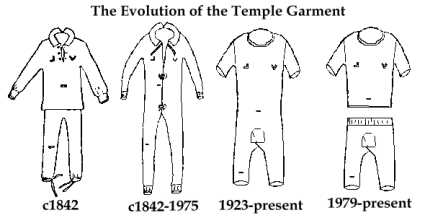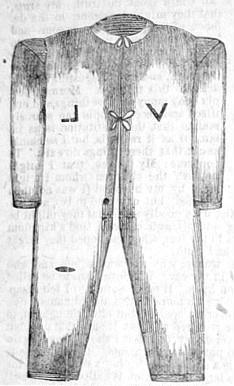Bullet Proof Mormon Underwear? August 8, 2013
Author: Beach Combing | in : Actualite, Contemporary, Modern , trackback***Dedicated to the Count, who gave me a pleasant hour on an unpleasant day. Beach should note here that he is not a fan of Mormonism but that he is a huge fan of Mormons: he has had consistently and powerfully positive experiences of followers of that religion and nothing that follows is meant to be offensive.***
Adult mormons wear temple garments that are essentially all-in-one pieces of underwear. (There is a modern and worrying tendency to wear them as two separate pieces – see graphic – but we do not condone that: the world is going to hell in a breadbasket…) Temple garments (aka Mormon underwear, aka ‘magic underwear’) are given to Mormons in a special temple ceremony and are, then, worn through life. The list of occasions when tgs can be removed is short. You can swim or bathe without them, and some liberals say that you can make love without them, but other than that that the tgs should become an extension of your body and a mark of your loyalty to God. Mormons justify the wearing of TGs through Genesis 3,21: ‘Unto Adam also and to his wife did the Lord God make coats of skins, and clothed them’. But, of course, TGs have a variety of functions that that verse does not cover. They encourage modesty in dress: mini-skirts and strapless dresses are not an option. They are a constant, if sometimes uncomfortable reminder, of God on your body: a very low grade version of the cilice. Unofficially, they are a way for Mormons to identify each other: ‘let’s go to that other saleslady. She’s wearing garments.’ Etc etc. Then, finally, they are a form of protection.
Modern Mormons are perhaps understandably worried about misunderstandings around the idea that temple garments are a ‘shield’. But the reference to protection is there in the initial giving ceremony.
Brother [insert name], having authority, I place this Garment upon you [for and in behalf of, insert name, who is dead], which you must wear throughout your life. It represents the Garment given unto Adam when he was found naked in the Garden of Eden, and is called the Garment of the Holy Priesthood. Inasmuch as you do not defile it, but are true and faithful to your covenants, it will be a shield and a protection to you against the power of the destroyer until you have finished your work here on earth. WiIth this Garment I give you an New Name, which you should always remember, and which you must keep sacred, and never reveal except at a certain place which will be shown you hereafter. The name is [insert name].
We are going to try very hard not to veer off course over that interesting point of the ‘new name’ and to concentrate on: ‘Inasmuch as you do not defile [the garment], but are true and faithful to your covenants, it will be a shield and a protection to you against the power of the destroyer until you have finished your work here on earth’. Beach can only see one way of reading this: if you are true then the garments will protect you from the Devil’s work. Of course, that could be read as a promise of day-to-day protection in the world – i.e. you live, the garmentless die; or simply as spiritual protection, perhaps you die but you are going straight to God. The garments also have a number of symbols placed on them. Some of these are practical: e.g. knee pads because we kneel to God. Others though are rather more esoteric: for example, the compass sign, which, it has been suggested, might have a Masonic origin.
The ambiguity over these symbols – there is lots of discussion as to what they mean – has perhaps helped along the idea that the tgs are magical and that they might be useful to have on you if someone pulls out a gun. This idea was certainly there in the early and difficult years of the church. Take this passage:
While the promise of protection attaching to the garment are chiefly of a spiritual nature, almost immediately after the endowment began to be performed in Nauvoo stories of the supernaturally protective power of the garment against physical harm began to circulate. At a meeting in the Nauvoo temple not long before the Mormon evacuation of the city, one Mormon recalled that, in the hostilities of the preceding autumn, ‘he was shot at, and the Sentinel who was near him was killed, but he escaped unhurt, having on his garment.’ At the same meeting, John Taylor, who had been severely wounded at the time of Smith’s murder in 1844, recalled, ‘Joseph and Hyrum and himself were without their robes [garments] in the jail at Carthage, while Doctor Richards had his on.’ Willard Richards, the only man of the group to wear his special temple garment in the Carthage jail, was also the only one to escape without a scratch. (Taysom 94)
The Church plays down these matters today but there are still accounts of underwear miracles in the Mormon underground. Mormon William Marriott went on 60 minutes claiming that his garments had protected him on a fire on a boat. Then there are other tales: ‘[a]s a missionary, I read a typescript account about an elder from that same mission who had been the victim of a drive-by shooting a year before (during the 1990 Gulf War): according to his mother’s account, bullets shredded his shirt without piercing his garments, while the only wound he received was from a bullet that hit him below the knee.’ Or what about this reflection from a contemporary Mormon on Yahoo Answers that shows that she has given some thought to the question.
I knew an entire family of temple-patron Latter Day Saints that were not only killed in a head-on collision, but disintegrated. I knew a man who had his endowments, and while the circumstances of his death were unclear, it was found that he had been partially consumed by animals after he had disappeared during a hunting trip. Police found his clothes scattered around the kill-site. But then again, I have heard and witness first hand other wonderful miracles where garments have been a protection. A friend was severely burned on the parts of his body where the garments didn’t cover – I saw that myself. So, I dunno. I know for sure that g’s didn’t keep the chiggers and ticks off me when I was out on coonhunts and such, if that means anything.
A sense of humour if probably the best protection of all. Beach should note that this particular Yahoo page is brilliant for an argument between a anti-Mormon and a Mormon: look out for the ‘I like your conviction so im adding you as a contact’.
How much should be made of the bullet-proof pants though? After all, many religions have special items of clothing and all religions have holy objects. There is an understandable attempt (or tendency) on the part of the faithful to equate miracles to these objects: medieval saint’s lives are full of stories about how the bones of St X saved priest Y; and a modern Christian topos (and one that Beach has always enjoyed) is the Bible (given by Mum) in the shirt pocket that stops the German bullet. Whether we have deliberately created bullet-stopping clothes, then, is doubtful: unless someone turns up some early Mormon writing on those mysterious symbols. On this subject an asinine video but one that made this blogger laugh: this reflects badly on said blogger…. The Count sent in this fascinating article that connected temple garments to the ghost dance! Well worth a read.
Any more on temple garments and protection? drbeachcombing AT yahoo DOT com




